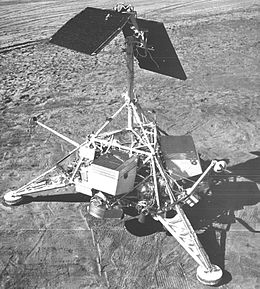Surveyor 1

Surveyor model on Earth
|
|
| Mission type | Lunar lander |
|---|---|
| Operator | NASA |
| COSPAR ID | 1966-045A |
| SATCAT № | 02185 |
| Mission duration | 65 hours |
| Spacecraft properties | |
| Manufacturer | Hughes Aircraft |
| Launch mass | 995.2 kilograms (2,194 lb) |
| Landing mass | 292 kilograms (644 lb) |
| Start of mission | |
| Launch date | May 30, 1966, 14:41:01 UTC |
| Rocket | Atlas LV-3C Centaur-D |
| Launch site | Cape Canaveral LC-36A |
| End of mission | |
| Last contact | 7 January 1967 |
| Lunar lander | |
| Landing date | June 2, 1966, 06:17:36 UTC |
| Landing site | 2°28′26″S 43°20′20″W / 2.474°S 43.339°W |
Surveyor 1 was the first lunar soft-lander in the unmanned Surveyor program of the National Aeronautics and Space Administration (NASA, United States). This lunar soft-lander gathered data about the lunar surface that would be needed for the manned Apollo Moon landings that began in 1969. The successful soft landing of Surveyor 1 on the Ocean of Storms was the first one by an American space probe onto any extraterrestrial body, and it occurred just four months after the first Moon landing by the Soviet Union's Luna 9 probe. This was also a success on NASA's first attempt at a soft landing on any astronomical object.
Surveyor 1 was launched May 30, 1966, from the Cape Canaveral Air Force Station at Cape Canaveral, Florida, and it landed on the Moon on June 2, 1966. Surveyor 1 transmitted 11,237 still photos of the lunar surface to the Earth by using a television camera and a sophisticated radio-telemetry system.
The Surveyor program was managed by the Jet Propulsion Laboratory, in Los Angeles County, California, but the entire Surveyor space probe was designed and built by the Hughes Aircraft Company in El Segundo, California.
The Surveyor series of space probes was designed to carry out the first soft landings on the Moon by any American spacecraft. No instrumentation was carried specifically for scientific experiments by Surveyor 1, but considerable scientific data were collected by its television camera and then returned to Earth via the Deep Space Network from 1966 to 1967. These spacecraft carried two television cameras — one for its approach, which was not used in this case, and one for taking still pictures of the lunar surface. Over 100 engineering sensors were on board each Surveyor. Their television systems transmitted pictures of the spacecraft footpad and surrounding lunar terrain and surface materials. These spacecraft also acquired data on the radar reflectivity of the lunar surface, the load-bearing strength of the lunar surface, and the temperatures for use in the analysis of the lunar surface temperatures. (Later Surveyor space probes, beginning with Surveyor 3, carried scientific instruments to measure the composition and mechanical properties of the lunar "soil".)
...
Wikipedia
